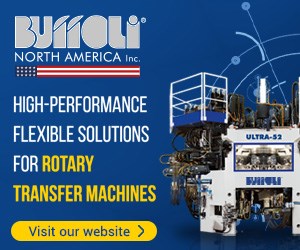Vertical Indexing Machine Produces Fittings With Greater Accuracy
This high production indexing machine is said to be able to produce a family of tees and elbows from a variety of materials with holes ranging in size up to ¾ inch NPT in mild steel.
The Govro Nelson Co. (St. Clair, Michigan) has developed a new vertical indexing machine using a Hirth gear to locate the index. By using different Govro machining units in various configurations, the 2000 vertical indexing machine has flexibility to produce a variety of different parts.
The new Hirth gear design gives the machine greater location accuracy and rigidity, increasing part precision and reproducibility. The rigid coupling of the index also increases the longterm accuracy of both the index location and the finished parts.
The high production machine is said to be able to produce a family of tees and elbows from a variety of materials with holes ranging in size up to ¾ inch NPT in mild steel. Changeover between parts requires a simple change of tooling and chuck jaws. The machine pictured offers 5-second cycle time and a part production rate of 720 per hour. It was designed for a family of three different parts with the capability of machining several others.
This machine has eight stations with self-centering two-jaw chucks to hold the parts. Up to 18 machining units can be configured on the machine depending on the operations required. The pictured machine includes 12 Model 46 drilling units that perform various cutting operations on three sides of the parts. Operations performed include a throughhole using opposed drilling heads, chamfering, tapping using opposed tapping heads and hollow milling.
With the Hirth gear, all index locations are positively and accurately held. The index face gear disengages from the mating fixed gear and is indexed using a Geneva-type drive. It then reengages with the fixed gear for accurate location. “This locating system produces twice the true position accuracy from part to part for all eight index locations compared to the accuracy of our shotpin type index drives,” says Roger Keylon, Govro’s general manager.
For flexibility, partspecific top jaws can be changed easily to a different part by removing two screws. The chuck jaw has a maximum opening of ¾ inch. Changeover to a new part is just a matter of switching top jaws, changing tooling and resetting the stops on the machining units. A skilled operator can easily change over the machine in an hour with preset tooling.
Govro offers automatic load and unload as an option. On the pictured machine, part blanks are loaded into a vibrator bowl that orients the parts and feeds them to a part nesting area where a robotic arm loads them into the chuck. A second robot arm then unloads the finished parts into a chute. With this equipment, this machine can run virtually unattended.
The machine uses an Allen Bradley PLC and interface terminal mounted to the machine, not on the floor, to conserve space. Optional automatic toollife cycle monitoring is available as well as a variety of other control options.
Govro's machining units have a concentric construction and combine air thrust, hydraulic feed control and positive stop all on the spindle centerline. Several models are offered.
Related Content
-
A Hydraulic Fitting Manufacturer’s Time of Transitions
This hydraulic fitting manufacturer uses innovative tooling, tool presetting, automated parts collection and its own expertise in custom workholding to enable its first CNC rotary transfer machine to effectively run smaller batches of parts than you might expect for this type of machine platform. This at a time when it also finds itself in a period of leadership succession planning.
-
Moen’s Flowing Success with Rotary Transfer Technology
The popular faucet manufacturer has adopted new CNC rotary transfer equipment to produce valves for its new generation of Widespread faucets.
-
High-Production Multitasking Becoming More Flexible
Rotary transfer machines remain well-suited for high-volume production, but are now more accommodating to smaller batch sizes.














